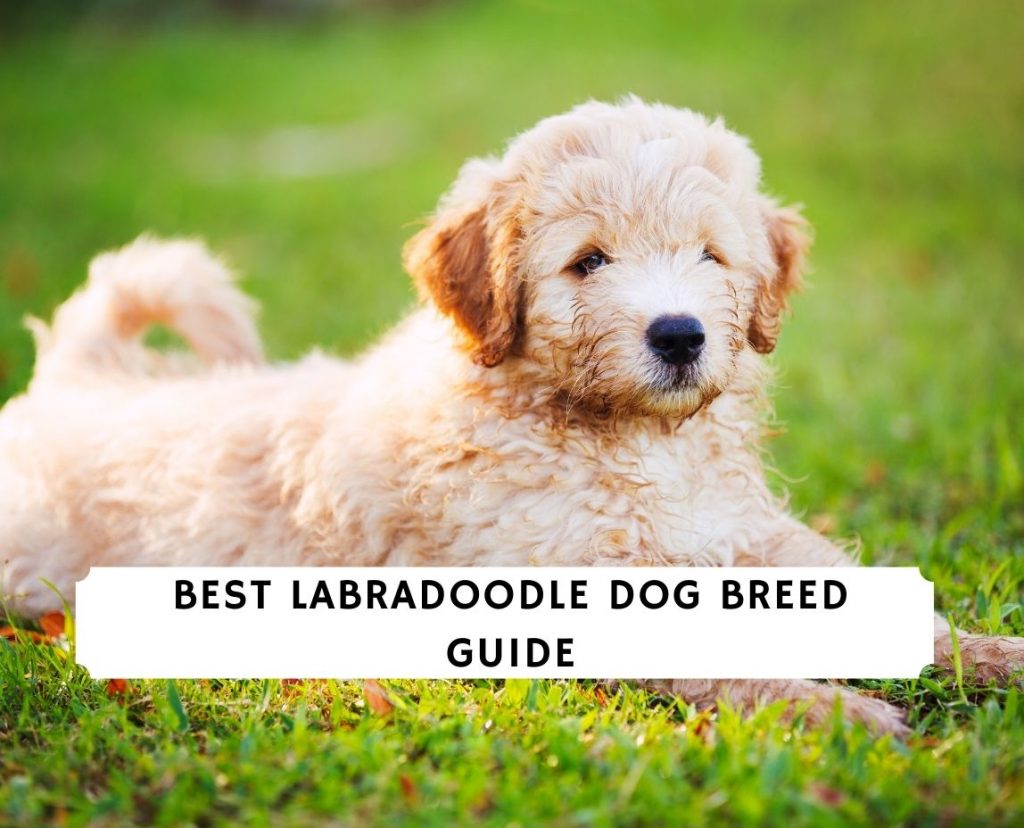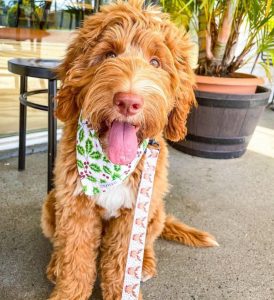
When a Labrador Retriever breeds with the Standard Poodle, the journey of a Labradoodle begins. Back then, the term “Labradoodle” wasn’t used until 1955. Similar to Bernedoodles and Goldendoodles, Labradoodles are great with children, people with allergies, families, and even guide dogs. This is one of the most popular crossbreed dogs in the entire world.
Whether you’re in search of a loyal companion or bringing home joy and happiness, a Labradoodle will help fill in those gaps for you. These dogs are loyal, intelligent, and affectionate when it comes to their owners. With the strength of a Labrador Retriever and the intelligence of a Standard Poodle, the Labradoodle makes the perfect family dog.
Characteristics of a Labradoodle
- Parent Breeds: Labrador Retriever + Standard Poodle
- Temperament: Smart, social, energetic, friendly, affectionate, etc.
- Typical Standard Height (Approx.): 24 to 26 inches tall
- Typical Standard Weight (Approx.): 55 to 90 pounds
- Life Expectancy: 12 to 15 years
A Labrador Retriever mixed with a Standard Poodle (or any size Poodle) will result in a Labradoodle. The uptrend in interests for the Labradoodle is mainly due to its temperament. When it comes to a Labradoodle’s temperament, they are intelligent, socializing, affectionate, easy-to-train, friendly, and many other things.
Origins
To fully understand the origin of the Labradoodle, we’ll have to go back and learn about its parents (Labrador Retriever mixed with the Standard Poodle).
- The Labrador Retriever came from Newfoundland, which was eventually introduced to England by fishermen in the 1800s. Back then, the Labrador Retriever was mainly used to assist hunters and farmers. With agility and strength, the Labrador Retriever can be useful for workers in the 1800s. These dogs can grow as high as 24.5 inches weighing between 55 to 80 pounds.
- As for the Standard Poodle, their origins are still up for debate until this day. With the information available, historians believe that the Standard Poodle originally came from Germany. There are theories that the Standard Poodle could be a cross between water dogs. As a house dog, Poodles are known to be intelligent and many owners raise them due to their curly hair. Because of the Standard Poodle’s curly hair, these dogs are described as non-shedding and allergy-friendly.
With the Standard Poodle and Labrador Retriever, the mix makes the perfect combination for a strong dog with the ability to be a quick learner. Along with that, they’re great for people with allergies due to the Labradoodle’s curly hair.
Generation Information
When it comes to a Labradoodle’s generation, there are 7 worth keeping in mind. These Labradoodle generations are F1, F1b, F2, F2b, F3b, Multigenerational Labradoodles, and Australian Labradoodles.
- F1 Labradoodle is a 50/50 cross between a Labrador Retriever and the Standard Poodle.
- F1b Labradoodle is a cross between an F1 Labradoodle and the Standard Poodle.
- F2 Labradoodle is an F1/F1b Labroodle mixed with another F1/F1b Labradoodle.
- F2b Labradoodle is an F2 Labradoodle crossed with the Standard Poodle.
- F3b Labradoodle is an F3 Labradoodle crossed with the Standard Poodle.
- Multigenerational Labradoodle is multigenerational, which means they are F1, F1b, F2, F2b + other generations mixed with F1, F1b, F2, F2b + etc.
- Australian Labradoodle generally gets mixed with the Aussiedoodle. Note that they’re not the same. This Labradoodle is mixed between the Labrador Retriever, English Cocker Spaniel, and the American Cocker Spaniel.
Related: Read our full article on all the Labradoodle Generations.
Size Information
There are five different sizes when it comes to the Labradoodle. There are micro, mini, small, medium, and standard sizes. The best way to distinguish the Labradoodle is by its size is by its weight and shoulder length.
- Micro Labradoodle – This Labradoodle weigh between 12 to 20 pounds and 12 to 14 inches at the shoulder.
- Mini Labradoodle – This Labradoodle weighs between 20 to 26 pounds and 14 to 16 inches at the shoulder.
- Small Labradoodle – This Labradoodle weighs between 26 to 35 pounds and 15 to 17 inches at the shoulder
- Medium Labradoodle – This Labradoodle weighs 35 to 50 pounds and 17 to 21 inches at the shoulder
- Standard Labradoodle – This Labradoodle weighs over 50 pounds and over 21 inches at the shoulder
Related: When is a Labradoodle Full Grown?
Temperament & Personality
Labradoodles are intelligent and affectionate dogs. Within the last decade, one of the reasons why the Labradoodle grew in popularity is because they’re traits and temperament. These dogs have a lot of energy and love to be playful around people and their surroundings. Other characteristics of the Labradoodle includes:
- Adaptability: Because of their adaptability, they’re able to adapt well to different environments. As for owners, they’re very affectionate which makes them perfect for beginner dog owners.
- Friendliness: Don’t mistake the Labradoodle for an aggressive dog because of its parent breeds’ hunting trait. The Labradoodle is known to be a friendly dog. Not only that they’re friendly to people they know but they’re friendly to strangers as well.
Nutrition
When it comes to feeding a Labradoodle, there are different ways for an owner to feed them. You can feed them kibble, moist food, cooked food, or raw food. Each method has its benefit but also overfeeding with the same method can be bad. For a Labradoodle owner, it’s better to diversify when it comes to feeding.
- Kibble: One of the most common feeding methods for any dog, in general, is kibble due to it being cheap and affordable for pet owners. While kibble is great, one of the cons of feeding your Labradoodle kibble is that it could lead to dental issues.
- Moist Food: Moist food can be canned chicken or vegetables. You can feed your Labradoodle moist food but make sure that you’re feeding it the proper nutrition. One of the cons of getting canned/moist food for your Labradoodle is that it can be costly.
- Cooked Food: This feeding method is starting to become more popular. Note that you should always be cautious when feeding your Labradoodle cooked food. There are certain things you can’t feed your Labradoodle because it can cause digestive problems. These food include onion, garlic, chives, etc.
Grooming
At first, it may sound complex but grooming your Labradoodle isn’t as difficult as you think. Although the work can be tedious, grooming your Labradoodle should be simple even for beginners. If you’re new to owning a Labradoodle, it’s best to understand that they require grooming more often than most dogs because of their curly non-shedding coats. There are owners out there that’ll cut their Labradoodle’s coat on their own to keep them mat-free.
If you’re inexperienced, don’t try this because it can cause your Labradoodle to feel uncomfortable and to potentially develop skin issues. Without experience, it’s recommended to take your Labradoodle to a professional groomer at least three times a year or once every 3 to 4 months. Grooming costs can range between $45 to $75 so be prepared to spend when the time comes.
Related: Labradoodle Grooming Guide
Exercise
Taking out your Labradoodle to exercise is as important as feeding it. The amount of exercise your Labradoodle needs depends on its age and size. When your Labradoodle is a full-grown adult, then you can take it out to exercise for an hour per day. Exercising your Labradoodle means:
- Taking it out for a walk
- Going for a jog with your Labradoodle
- Letting your Labradoodle play in the backyard
There are many ways you can let your Labradoodle exercise. If your Labradoodle is still young, then you can let it exercise for 5-10 minutes per day and gradually increase it as they become older. You can challenge your Labradoodle physically by training it because letting it run an hour a day isn’t the best way. It’s better to diversify your Labradoodle’s exercises.
Training
Due to the Labradoodle’s intelligence, they’re known to be easy-to-train. Unlike most dogs, the Labradoodle doesn’t tend to bark or howl as much. When you’re going to train a Labradoodle, there are several things to follow before you start your training. Whether they’re Labradoodle puppies or adults, these training tips will help you.
- Training requires control. You’ll have to control your Labradoodle: Whether you adopted an adult Labradoodle or brought one home as a puppy from a breeder, it won’t completely understand you. To help your Labradoodle transition in, you’re going to have to lead the way and controlling them properly whether it’s rewarding them for good behavior, etc.
- Repeat whatever’s working: Just like humans learning, you’re going to have to train your Labradoodle and repeat what’s working. They’ll make mistakes but the more you train them, the less likely they’ll repeat the same mistake. It’ll be difficult at first but it gets easier as your Labradoodle will adjust to good behaviors.
- Teach your Labradoodle one thing at a time: Your Labradoodle will get exhausted and training them multiple things at once will tire them out. It’s better to teach them one thing at a time. If your Labradoodle can sit on command, then it’ll be ready to learn to walk by your side.
- What to do if your Labradoodle lost interest: Labradoodles can sometimes lose interest in what you’re teaching them and that’s fine. When your Labradoodle loses interest, try teaching them different things. Move to a different area and train your Labradoodle at something they’re good at.
- Getting your Labradoodle to return to you: When you’re first living with your Labradoodle, sometimes they won’t return to you on command. After all, it’s their natural habitat. What you can do in this situation is to put a leash on your Labradoodle. By doing this, you can reward them with treats every time they return to you after calling them. Generally, it could take up to a month to get your Labradoodle to be fully-trained when calling them back on command.
- Know when to stop: Labradoodles aren’t robots and they’ll get exhausted. As a Labradoodle owner, you should know when they’re tired and when to stop training. Sometimes, owners will mistake the exhaustion of a Labradoodle for boredom. There’s a chance that it’ll be annoyed by their owners commanding them constantly. It’s okay to give your Labradoodle a break. Training takes time.
Health
Since the Labradoodle is a hybrid dog, it has the potential to develop health issues. This applies to all hybrid dogs. If you’re planning on bringing your companion home from a Labradoodle breeder, try to bring one home from a breeder that offers a health guarantee. One red flag to watch out for is when a breeder promises that they have 100% healthy dogs. It’s better to bring home a companion from an honest breeder than a breeder giving you false confidence. Instead of purchasing your Labradoodle from potential puppy mills, it’s better to spend a little time doing your own due diligence to find a reputable trusted breeder.
The fact that the Labradoodle is mixed between a Labrador Retriever and the Standard Poodle, they can struggle with health problems from their parents’ breeds. These conditions include:
- Hip dysplasia and elbow dysplasia
- Progressive retinal atrophy (eye disease)
- Von Willebrand’s disease
- Bleeding disorder
If you ask, most Labradoodle breeders will provide you with information from their parents. Try to avoid bringing home a Labradoodle if a breeder doesn’t provide you with any health information. You can avoid expensive bills from the veterinarian by purchasing pet insurance for your Labradoodle.
Appearance
The appearance of a Labradoodle depends on its generation. Whether they’re F1s or F1bs, it all comes down to generation type. For example, F1 Labradoodles will have less curly hair and it’ll appear wavier. If it’s an F1b Labradoodle mixed with F2 Labradoodle, then the hair should appear more curly. In the Labradoodle community, people often describe them as teddy bear-like in appearance. Labradoodles come in a variety of colors and coat types such as chocolate, red, white, black, etc.
Related: Labradoodle Colors
Price
Within the last decade, there’s been an uptrend in interests for Labradoodles. With more demand, the cost to bring home a Labradoodle can be quite costly. The average cost of a Labradoodle can range between $500 to $3,000 depending on its appearance, generation type, and many other factors. If you’re planning on bringing home a Labradoodle from a rescue, then it can range anywhere between $50 to $300. This guide might help you if you’re in search of the best Labradoodle breeders in the United States.
Related: How Much Does a Labradoodle Cost?
Frequently Asked Questions
Is a male or female Labradoodle better?
When it comes to male or female Labradoodles, one isn’t necessarily better than the other. Choosing which one is right for you is a personal choice and one only you can make. When it comes to the temperament of Labradoodles, it’s the same for male and female Labradoodles.
There’s no aggression with male Labradoodles, although you might find they enjoy humping if they are not neutered. You should consider the cost of neutering them when deciding if a Labradoodle is right for you.
Female Labradoodles are slightly smaller than males, ao if you are after a smaller dog, a female might be the better choice for you. It’s also worth considering any other pets you have. You might not want to bring a female Labradoodle into your home if you have a male that isn’t neutered unless you want puppies, of course!
Consider these factors, but you can rest easy knowing that whichever you choose will be a playful and welcome addition to your home!
Are Labradoodles smelly?
Generally, no, Labradoodles are not smelly. Most Labradoodles have a non-oily coat thanks to their Poodle genes; they will have little to no natural odor. That means the typical dog smell will be absent. These coats are also typically hypoallergenic and will require regular brushing to prevent any matting or knots.
However, if your Labradoodle has a straighter coat, it might be more susceptible to smell. A straight coat comes from the Labrador Retriever parent and is more commonly seen in F1 Labradoodles. It doesn’t always have the non-oily lining and means it can pick up odor easier. Knowing what coat your Labradoodle has allows you to determine easily if it will be smelly or not.
No matter the coat they have, your Labradoodle can still smell. They can pick up odors from other dogs, swimming, or roll in the mud and grass. Washing them after this with the correct shampoo for their coat can help remove the odor and restore their coat to its former glory.
Remember to use the right shampoo for your Labradoodle and consider any skin conditions they might have when making your decision.
Do Labradoodles bark a lot?
Yes, Labradoodles do bark, but not too much. They are considered moderate barkers. It means that they shouldn’t bark for no reason, but if something triggers your Labradoodle, then it will bark.
Once you have established your Labradoodle’s triggers, you can easily train them not to bark. The training should not be too difficult, especially if you begin when they are young and remain consistent. You can speak to your vet or a dog trainer if you need advice on this.
Typical triggers for Labradoodles are doorbells or doors being knocked, people entering the house, or animals outside making noise. They also bark when being left alone or if they are trying to protect themselves or you.
While these are the most common, virtually anything can trigger a Labradoodle and make them bark. It could be the sound of your phone ringing or a particular TV advert. Once you have established what these are, you can train them not to bark at these triggers.
Labradoodles are intelligent dogs and responsive to training, so you should encounter little to no trouble when doing so. There’s also plenty of solutions that you can try to reduce your Labradoodle’s barking if you are concerned.
Are Labradoodles destructive?
Labradoodles can be destructive, yes. They tend to be more destructive during their puppy years, especially when they are teething, as they will chew on items to relieve any discomfort they are feeling. Like other breeds, Labradoodles aren’t afraid to steal a sock or slipper and get to chewing.
Providing your Labradoodle with toys that relieve teething can be helpful here, and keeping anything they might chew out of their way. However, it’s not the only reason Labradoodle will chew or be destructive.
Typically, Labradoodles will be destructive when they are bored, especially when they are puppies. These social dogs do not like being left alone and can become bored easily.
Provide them with lots of exercises before leaving them home alone so they are more tired and less likely to become bored, or plenty of stimulating toys that will stop them from destroying your home!
Labradoodles can also be destructive when they are feeling anxious. If your Labradoodle is anxious, providing them with comfort and reassurance can help. It’s also worth seeking professional help if this frequently happens.
Generally, Labradoodles grow out of feeling destructive, and you can combat it with exercise and plenty of distractions.
Do Labradoodles like to cuddle?
Yes, Labradoodles like to cuddle! These affectionate dogs enjoy a cuddle with their owners or settling down into their beds and cuddling their favorite toys. Labradoodles are friendly and extremely affectionate, meaning cuddles are at the top of their priority list!
As a breed, they love to spend time with their owners and aim to please them, meaning if you want a cuddle, chances are you are going to get one! They especially enjoy them when they are sleepy and you have a blanket close by! You can expect lots of cuddles in the evenings or after playtime.
Labradoodles are friendly with everyone, so providing they are properly socialized, they should even cuddle visitors you have in your home! We do think it’s best not to force it though, let your Labradoodle come to you for a cuddle when they are ready. Forcing them to stay or placing them in an enclosed space for a cuddle can stress them out on times.
Overall, your Labradoodle is likely to love cuddles and stop you from the housework. Is there a better excuse than being stuck under a dog not to do the cleaning?
Do Labradoodles love their owners?
Yes, Labradoodles love their owners! These social dogs are extremely affectionate, and it does not take them long to bond with their owners.
Labradoodles are very friendly too, helping them to bond with their owners and new family quickly. It shouldn’t take more than a few days after bringing your Labradoodle home for them to bond with you (unless they have any anxiety or behavioral problems).
Labradoodles, by nature, are affectionate, friendly, and affectionate. They also like to please their owners and show their affection this way. You can expect regular eye contact and your Labradoodle to sleep on or near you as a sign of this affection and love.
They will also be excited to see you whenever you return home and want to be near you. In return for all this love and affection, make sure that your Labradoodle is comfortable in a new environment. They will look to you for security in these situations. Eye contact and physical contact is usually the best option here.
Their love and affection for their owners make Labradoodles the perfect pet for families or first-time dog owners too.
At what age do Labradoodles calm down?
These active dogs don’t usually calm down until they are 3-4 years old. Labradoodles are incredibly loving and affectionate dogs, often with lots of energy to burn off, especially when they are puppies or young dogs. You can usually burn off this energy with daily walks and playtime, but any owner will tell you, Labradoodles tend to be excited and hyper dogs!
By the time they reach 2, Labradoodles are usually fully grown and will tend to calm down. The young puppy energy should calm down, and you should notice that your Labradoodle won’t be as hyper. For some Labradoodles, it can take until they are four years old for them to calm down and seem more like adult dogs.
However, these friendly dogs will always have high energy levels to make them seem hyper or crazy. You should notice that your Labradoodle will be calmer after a walk or playtime. Daily walks and playtime will calm them down at any age, just don’t exceed the recommended amount for their age.
The energy levels vary from dog to dog, exercises and providing you have a calming environment for your Labradoodle; they should calm down as they age.
If your home is loud, chaotic, or more lively, then your Labradoodle is likely to match that. Consider how you can make your home calmer and ensure plenty of exercises to calm your Labradoodle down at any age.
Conclusion for Labradoodle Dog Breed Guide
Today, Labradoodles are amongst one of the popular Poodle mixes out there with Goldendoodles and Bernedoodles. With a variety of sizes and colors to choose from, Labradoodles are great for families and people with allergies. Not only do they flood their owners with affection, but Labradoodles also work as guide dogs and therapy dogs.
If you need an easily trainable companion, then it’s definitely one of the Poodle mixes out there to keep an eye on. Raising a Labradoodle can be exhausting at times but the reward is priceless. The journey of raising a Labradoodle will create lifetime memories that you’ll cherish for the rest of your life.
For other Labradoodle guides and info, check out:
Garrett loves animals and is a huge advocate for all Doodle dog breeds. He owns his own Goldendoodle named Kona. In addition, he volunteers at the Humane Society of Silicon Valley, where he fosters dogs and helps animals. Garrett enjoys writing about Doodles and believes that dogs can teach humans more about how to live than humans can teach a dog.
Why Trust We Love Doodles?
At We Love Doodles, we’re a team of writers, veterinarians, and puppy trainers that love dogs. Our team of qualified experts researches and provides reliable information on a wide range of dog topics. Our reviews are based on customer feedback, hands-on testing, and in-depth analysis. We are fully transparent and honest to our community of dog owners and future owners.






